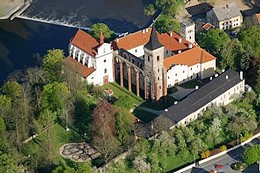
The Sázava Monastery wants to open the gardens that have been closed for 100 years
 |
| source: www.klaster-sazava.cz |
In the future, people will be able to walk along paths in the rocks and terraces above the river, where a small pier with boats is also planned. "From here or from the northern garden with the foundations of the Romanesque Church of the Holy Cross from the 11th century, they will be able to walk to the Marian Garden, which features a large number of rare trees," said the castle keeper. In the Marian Garden, a space under three pines resembling a natural chapel is planned for a modern statue of the Virgin Mary.
The neighboring western garden will also be made accessible. It is planned to have a cleft-free area, fruit bushes, but primarily this place historically used as the economic base of the monastery and the monks' vegetable garden will be designated for active relaxation for children and adults. A natural grassy playground, a fire pit, fruit trees, and possibly several domestic animals will also be included.
The most beautiful place in the monastery - the paradise garden, a green square in the middle of the former monks' dwelling, which is a place for meditation and quiet appreciation of nature's beauty in every monastery, is also waiting for its restoration. "Significant symbolic elements were water and tree, which will return here in the form of a well and a flowering apple tree. There will also be a large quantity of herbs, spices, and roses in three colors symbolizing the virtues of monastic Benedictine life," added Matoušová.
Part of the restorations includes the St. Procopius cave, which was discovered after the Second World War by the Sázava priest Father Method Klement. The study for its restoration was approved last year. A project for the reconstruction and connection of the legendary hermit Procopius's dwelling with the crypt, where his symbolic grave lies, is currently being prepared. "In the Middle Ages, there was a chapel there; it was a very crucial place. We want to rebuild it anew, but we have nothing to lean on because we don't know what the crypt looked like," said the castle keeper.
Next year, the National Heritage Institute wants to apply for a grant from the so-called Norwegian funds with the project for the restoration of the cave. If successful, this place, which is crucial for the Sázava Monastery, could be revitalized and made accessible to the public within five years.
The revitalization of the gardens is estimated to cost more than 32 million crowns, while the cave restoration will require another 13 million crowns.
The English translation is powered by AI tool. Switch to Czech to view the original text source.
0 comments
add comment










